Do you want to add a touch of natural beauty and freshness to your garden? Hanging vegetable gardens are a great way to enjoy homegrown produce all season long.
Whether you have limited space, or just need decoration ideas for an outdoor area, adding a hanging edible garden is sure to spruce up the look and bring life into your home.
In this blog post, we’ll share some creative ideas on how to create and maintain a beautiful vegetable garden that hangs from the ceiling or walls of your home.
We’ll cover tips on what kinds of vegetables work best in planters so they get enough light, water them correctly without spilling over the sides, and show off unique DIY designs you won’t find anywhere else! So if you’re looking for ways to make the most out of small spaces in gardening – read on!
Benefits of Having Your Own Hanging Vegetable Garden
Saves space
With vertical hanging gardens, you can get the same benefits of growing vegetables without taking up valuable ground space. This is especially beneficial for those with limited outdoor areas or balconies.
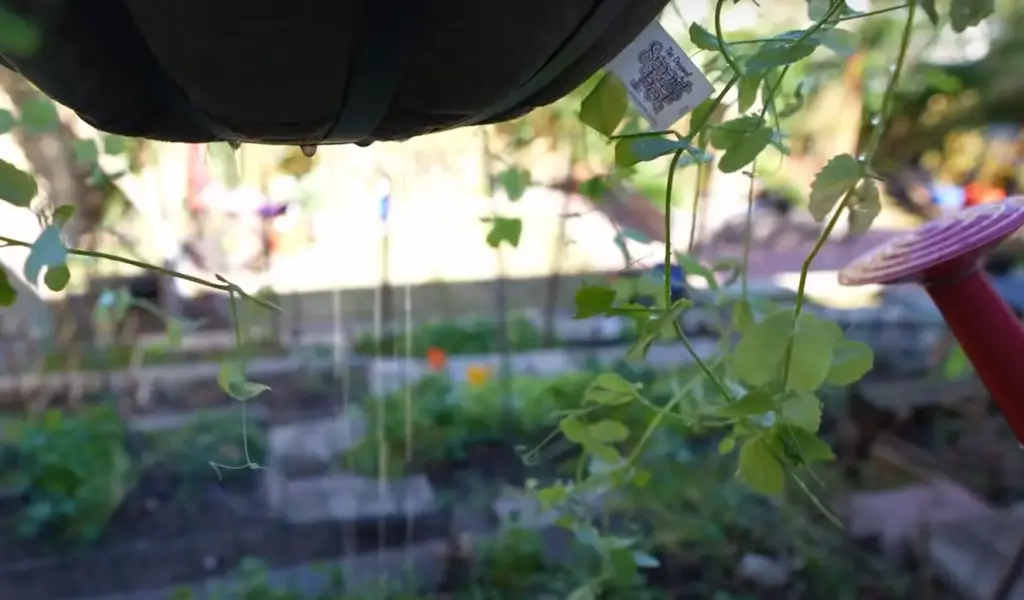
With some clever design, you can capitalise on either a small patch of land or any other unused space in your yard.
Lowers risk of pests
When plants are grown off the ground, they’re much less prone to pests and diseases that can ruin traditional vegetable gardens.
This is especially true when it comes to root-rotting fungi, which thrive in moist soil. With a hanging garden, your vegetables are much safer from these harmful organisms.
Easy to maintain
These gardens are easy to maintain and don’t require a lot of effort or time. You can water them less frequently than traditional gardens, since the soil drains more quickly. Plus, you won’t have to worry about weeds as much since they’re growing off the ground.
Aesthetically pleasing
Hanging garden designs look great, adding a fun and quirky touch to your outdoor space. Whether you choose to hang planters on poles or walls, they can be as decorative as they are functional.
You can also get creative with the types of plants you choose for displays; some popular options include leafy greens, herbs, and trailing flowers.
What Can You Grow and Cultivate in a Hanging Vegetable Garden?
Cherry tomatoes
Cherry tomatoes are ideal for hanging gardens because they don’t take up too much space and can be grown in planters. They’re incredibly versatile, so you can grow them indoors or outdoors, in sunny spots or shady areas. Plus, their bright colours will liven up any outdoor area.
Carrots
Carrots are another great choice for hanging gardens. They don’t require a lot of care and grow well in planters or hanging baskets. Just make sure to provide them with plenty of water, fertiliser, and sun.
Radish
Radishes are perfect for small-space gardening since they don’t take up much room. They have a short growing season and can be harvested quickly, making them great if you’re short on time.

Plus, they come in all sorts of colours, shapes, and sizes so you can make an interesting display with your planters.
Spinach
Spinach is a great choice for hanging gardens because of its compact size. It grows quickly, so you can harvest it in a few weeks. Plus, it’s packed with vitamins and minerals, making it a nutritious addition to your diet!
Lettuce
Lettuce is another great option for hanging gardens, as it takes up minimal space and grows quickly. It’s easy to care for and doesn’t require a lot of attention, so you can enjoy fresh salads all season long.
Strawberry
Strawberries are a great choice for hanging gardens because they’re easy to grow and require little maintenance. Plus, they’re incredibly versatile — you can make jams, pies, or just eat them fresh!
Herbs
Herbs are a must-have for hanging gardens since they’re so easy to grow. They require minimal care and you can use them in all sorts of dishes, from soups to sauces.
What are the Best Hanging Vegetable Garden Ideas?
Build your vertical vegetable garden
One of the best ideas for a hanging vegetable garden is to build your own vertical one.
You can design it however you want, from basic shelves to intricate walls filled with planters. This allows you to maximise space while still creating a beautiful and functional display.
Use hanging baskets
Hanging baskets are an easy and affordable way to create a hanging vegetable garden.
Just make sure to choose baskets that are deep enough for the vegetables you want to grow, and keep in mind that they may need extra support when filled with soil.
Make your green wall
If you have limited space, a green wall is the perfect solution. You can mount it on a wall or fence for maximum efficiency and create an interesting display with various types of vegetables.
Grow veggies in hanging planters
Hanging planters are a great way to save space while still being able to grow your favourite vegetables.
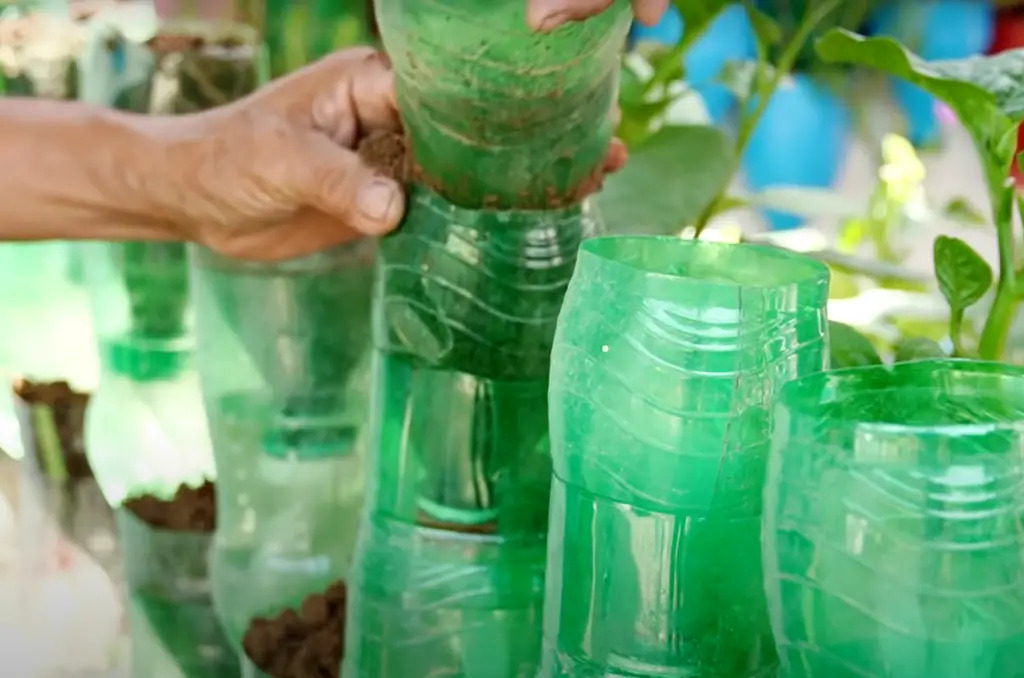
You can hang them from a balcony or wall, and choose different shapes and sizes to create an eye-catching display.
Take advantage of a cedar raised garden bed
If you’re looking for something more permanent, a cedar raised garden bed is a great option. It’s simple to assemble and provides plenty of room for vegetables like tomatoes or peppers. Plus, it looks great and can be easily moved when needed.
Use tin cans
Tin cans make great hanging planters for a variety of vegetables. Just drill some holes, fill them with soil, and add your favourite veggies. Plus, they’re inexpensive and can be easily hung from a fence or wall.
Grow tomato plants upside down
If you want to be creative, why not try growing your tomatoes upside down? All you need is a bucket and some twine, and you’ll have an interesting hanging garden that will provide plenty of juicy tomatoes.
Use plastic bottles
Plastic bottles can be used to create a hanging garden for small-space gardening. Just cut off the bottom and hang them from your balcony or wall, fill them with soil, and add your favourite herbs or veggies. Plus, they’re eco-friendly!
Make a garden pot holder with a wooden ladder
If you want to add a rustic touch to your garden, why not try making a pot holder with a wooden ladder? Just attach some chains to the ladder and hang your planters from them. You can fill each rung with different plants for an interesting display.
Use stacked pots
Stacked pots are another great option for hanging gardens. All you need is a pot, stakes, and soil to make one. Plus, they’re easy to move around if needed.
How to Make a Hanging Vegetable Garden?
Give them sufficient water
Hanging vegetable gardens require a lot of water, especially during the hot summer months.
You can also use a drip irrigation system if you want an easier way to do it.Install the planters and hooks properly
If you’re using hanging baskets or planters, make sure to install them properly. Hang the baskets from strong hooks and use sturdy construction screws for the planters.
Harvest on time
Harvest your vegetables when they’re ripe and ready to eat.

Most vegetables should be harvested as soon as they’re mature so that you can maximise the yield.
Ensure that there is adequate sunlight
Like any other type of garden, your hanging vegetable garden needs plenty of sunlight to thrive. Make sure that it gets at least 6-8 hours of direct sunlight per day.
Use pots with proper drainage
Make sure to use pots with drainage holes in the bottom so that excess water can drain out. This will help prevent root rot and keep your plants healthy.
Choose the right fertilisers
Fertilise your hanging vegetable garden regularly to ensure that it’s getting all the nutrients it needs. Choose a fertiliser that’s specifically designed for vegetables, and follow the instructions on the label.
By following these tips, you can create a beautiful and functional hanging vegetable garden that will provide you with fresh produce all season long. With a little bit of planning and some creativity, you can easily transform your outdoor space into an oasis of delicious vegetables.
FAQ
What vegetables do well in hanging baskets?
Tomatoes, peppers, and herbs are all great choices for hanging baskets. Other vegetables that do well in this type of garden include cucumbers, squash, and beans.
How much light does a hanging vegetable garden need?
A hanging vegetable garden needs at least 6-8 hours of direct sunlight per day. If your space doesn’t get enough light, you can use grow lights to supplement the natural sunlight.
How often should I water my hanging vegetable garden?
Your plants need at least an inch of water per week. You may need to water more frequently during hot, dry weather. Monitor the soil moisture levels and adjust your watering schedule accordingly.
What is the best way to fertilise my hanging vegetable garden?
Choose a fertiliser that’s specifically designed for vegetables and follow the instructions on the label. You may also want to add organic matter, such as compost or manure, to enrich the soil in your hanging vegetable garden.
Can I hang my vegetable garden in a small space?
Yes, you can. Hanging vegetable gardens are great for small spaces because they don’t take up any floor space. They also provide more air circulation than other types of gardens, which helps with temperature regulation and pest control. Plus, they look great!
How do you grow a vertical vegetable garden?
You can grow a vertical vegetable garden in several ways. You can use hanging baskets, stacked pots, or even tiered planters. Make sure to choose the right plants for your space and give them enough light, water, and nutrients.
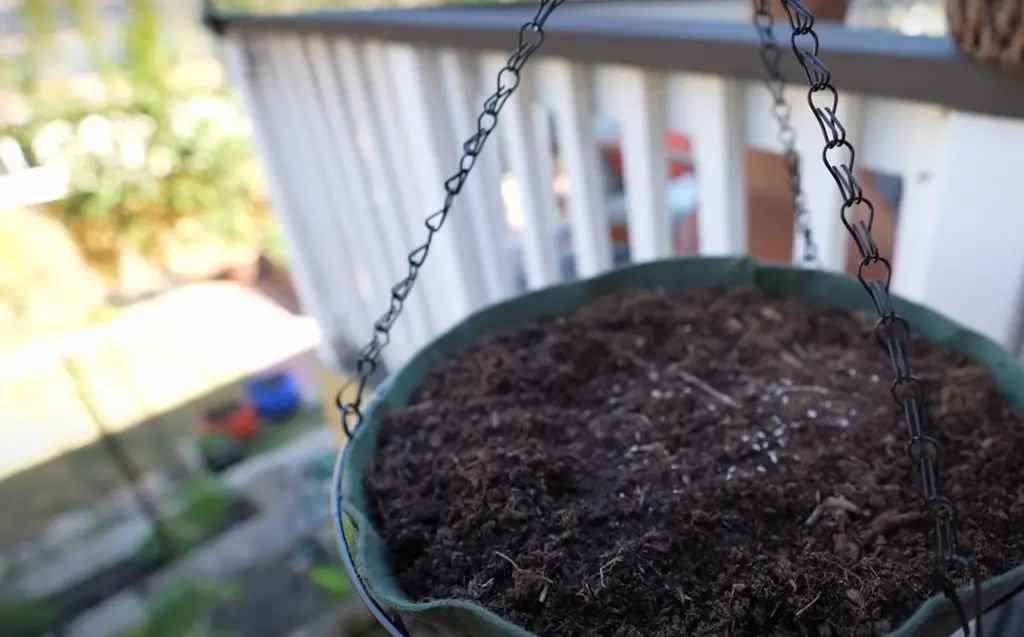
With some creativity and planning, you can easily create a beautiful vertical vegetable garden that will provide you with fresh, delicious vegetables all season long.
What’s good as a hanging garden?
Many vegetables, herbs, and flowers can be grown in hanging gardens. Some of the most popular choices include tomatoes, peppers, beans, squash, cucumbers, strawberries, and herbs such as basil and oregano.
You can also choose trailing annuals or perennials such as petunias and sweet alyssum to add colour to your hanging garden.
How can I make a hanging garden?
Creating a hanging garden is relatively easy. All you need is a sturdy structure such as an arbour, trellis, or fence where you can attach the hangers for your pots. You’ll also need to choose the right plants and make sure they get plenty of sunlight and water.
Finally, use potting soil specifically designed for containers and add fertiliser according to the instructions on the label. With some planning and creativity, you can easily create a beautiful hanging garden that will provide you with fresh produce all season long.
What is the easiest hanging plant to grow?
For those just starting out with hanging gardens, some of the easiest plants to grow are herbs such as oregano and basil. These herbs generally require minimal care and will thrive in containers or hanging baskets.
Other easy-to-grow hanging plants include strawberries, tomatoes, peppers, squash, and cucumbers.
What veggies are best for a vertical garden?
Tomatoes, cucumbers, peppers and squash are all great choices for a vertical garden. Trailing plants such as sweet peas and morning glories work well too, adding beautiful colours to your vertical space.
Herbs such as oregano and basil can be grown in hanging baskets or staked pots too.
What is the best soil for a hanging vegetable garden?
You’ll need to use a potting mix specifically designed for containers when creating your hanging vegetable garden.
This type of soil will provide excellent drainage, water retention, and aeration for your plants. Make sure to add fertiliser according to the instructions on the label for maximum growth potential.
What are the benefits of a hanging vegetable garden?
A hanging vegetable garden can be a great addition to any space. It doesn’t take up any floor space, is easy to maintain, and provides more air circulation than other types of gardens which helps with temperature regulation and pest control.
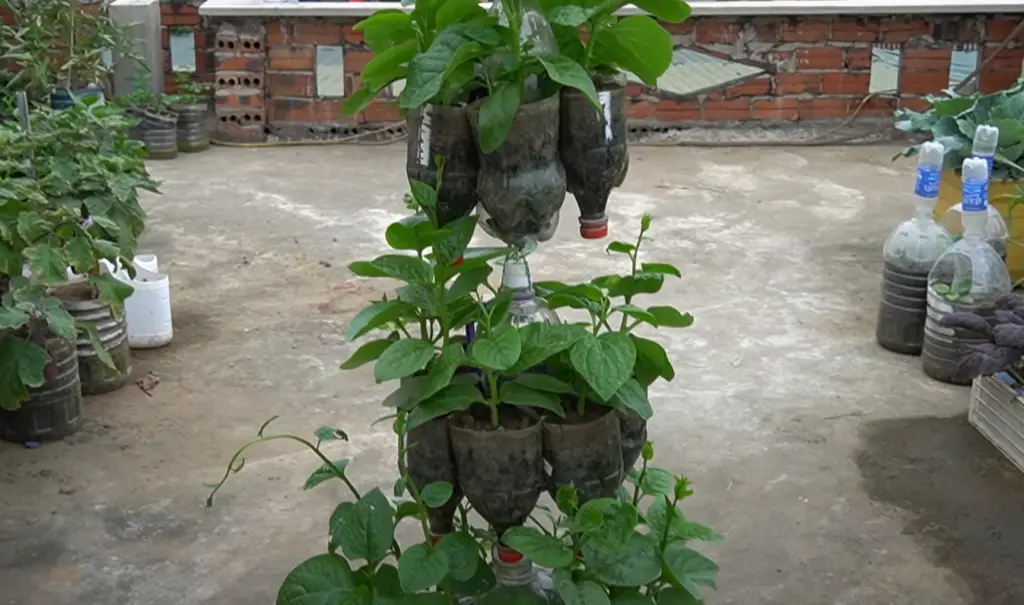
Plus, it looks beautiful! Hanging vegetables will also provide you with fresh, delicious produce all season long.
What other tips should I consider?
When creating a hanging vegetable garden, keep in mind that the plants need at least six hours of sunlight each day and enough water to keep them hydrated. You’ll also want to add organic matter such as compost or manure for soil enrichment.
Finally, be sure to regularly check for pests or diseases and treat accordingly. With a little bit of planning and care, you can easily create a thriving vertical vegetable garden that will provide you with delicious, fresh produce all season long.
What are some creative hanging garden ideas?
There are endless possibilities when it comes to creating a unique and beautiful vertical vegetable. You can opt for rustic wood frames using an old ladder to hang pots. Or, you can take the modern route with sleek metal. Don’t be creative with your design!
For added visual interest, consider mixing in some trailing plants such as petunias or sweet alyssum. Hanging baskets are also an excellent way to make use of vertical space and add colour to your garden.
Whatever you decide, just remember to choose the right plants for your climate and provide them with plenty of sunlight, water, and nutrients.
How do I maintain my hanging vegetable garden?
Maintaining a hanging vegetable garden is relatively easy. Make sure to check the soil moisture regularly and water as needed. You may also want to add organic matter such as compost or manure to the soil periodically for added nutrients.
Additionally, be sure to inspect your plants regularly for pests or diseases and treat them accordingly. Finally, don’t forget to harvest your vegetables when they are ripe and ready!
How do I know when to harvest?
Harvesting times will vary depending on the type of vegetable you are growing, but as a general rule it’s best to pick vegetables once they have reached their full size and colour. For example, tomatoes should be picked when they are fully red and peppers should be picked when they are bright green or orange.
Additionally, be sure to keep an eye out for any signs of disease or pests. If you notice anything unusual, remove the affected plants immediately and dispose of them appropriately.
How can a hanging vegetable garden save me money?
Growing your own vegetables in a hanging garden is a great way to save money on produce.
You’ll be able to enjoy delicious, homegrown food without having to spend a fortune at the grocery store. Additionally, since you are growing the plants yourself, you know exactly what has been used in their care which is great for people who are trying to eat organic.
Finally, a hanging vegetable garden can also save you money on utilities by providing natural insulation and cooling during the summer months.
How much time does a hanging vegetable garden require?
The amount of time required to maintain a hanging vegetable garden will vary depending on the size and complexity of your setup. Generally speaking, you should expect to spend at least 10-15 minutes each day inspecting your plants for pests or diseases and checking soil moisture levels.

Additionally, you’ll need to water your plants regularly and provide them with additional nutrients as needed. Finally, you’ll also need to harvest your vegetables when they are ripe and ready. All in all, a hanging vegetable garden is a great way to save time and money while providing fresh, delicious produce all season long.
How do I choose the right plants for my hanging vegetable garden?
When choosing plants for your hanging vegetable garden, it’s important to consider your climate and local growing conditions. You’ll also want to select varieties that are suited for vertical growth and have a relatively short harvest time such as beans, peas, peppers, tomatoes, and cucumbers.
Additionally, be sure to choose plants that provide the right amount of sunlight and are drought-tolerant as these will require less maintenance. Finally, don’t forget to mix in some flowering annuals for added colour and visual interest!
Why should I consider a hanging vegetable garden?
A hanging vegetable garden is an excellent way to make use of vertical space in your yard, or even on your porch or balcony. Additionally, it requires minimal maintenance and provides easy access to fresh, homegrown produce all season long.
Finally, it’s also a great way to save money on utilities as it provides natural insulation and cooling during hot summer months. With all these benefits, there’s no reason not to give it a try!
Why should I choose a hanging vegetable garden over traditional gardening?
Hanging vegetable gardens offer several advantages over traditional gardening. First and foremost, they allow you to grow more plants in less space. Additionally, since the plants are up off the ground, they require less weeding and maintenance than their ground-level counterparts.
Finally, since most of these systems are self-watering, they can be a great way to save time and effort. With all this in mind, it’s easy to see why a hanging vegetable garden is an attractive option for anyone looking to start their own backyard or urban farm.
Does a hanging garden require special tools or equipment?
No, you don’t need any special tools or equipment to get started with your hanging vegetable garden. However, it is important to have the right supplies on hand such as soil, compost, fertiliser and mulch.
Additionally, you may want to invest in a hanger or trellis to help support your plants. Finally, you’ll also need some basic gardening tools such as a shovel, trowel and pruners to keep your garden in tip-top shape.
With the right supplies, you can easily get started on creating your own hanging vegetable garden!
Do I need to use organic methods?
Organic methods are not required for a hanging vegetable garden but they can be beneficial. Using organic gardening techniques can help you reduce your environmental impact as well as minimise the risk of pests and diseases.
Additionally, some organic fertilisers and amendments have also been found to improve soil quality and plant productivity. Finally, many organic methods are also low-cost and sustainable which can help you save money in the long run.
Whether or not you choose to use organic methods is ultimately up to you, but it can be an excellent way to ensure a healthy and productive garden for years to come.
Does a hanging vegetable garden need regular maintenance?
Yes, a hanging vegetable garden will require some regular maintenance in order to ensure good growth and productivity. This includes tasks such as pruning, weeding and feeding the plants with fertiliser as needed.
Additionally, you’ll want to check for pests and diseases regularly and treat them accordingly. Finally, you’ll also need to water the plants on a regular basis, especially during periods of extreme heat.
Do I need to provide additional support for my plants?
Yes, you will likely need to provide additional support for your hanging vegetable garden.
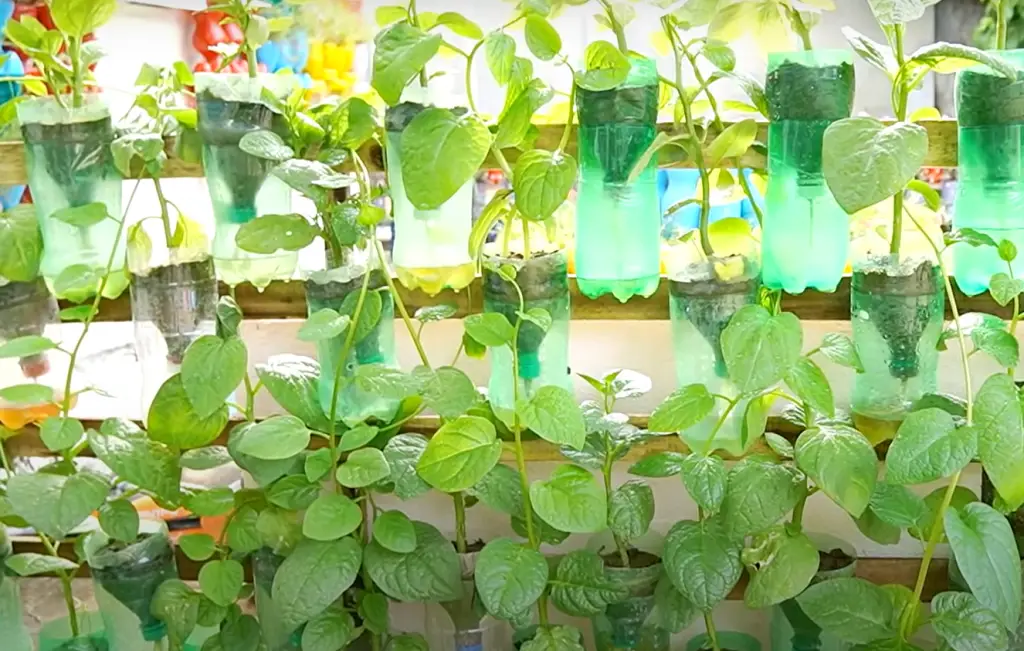
This can include things like trellises and strong stakes that are designed to hold up the weight of heavier produce such as tomatoes and cucumbers. Additionally, some plants may require pruning or tying back in order to keep them from sprawling out too far.
With a few simple measures, you can ensure that your hanging vegetable garden is supported and ready to thrive!
Does a hanging vegetable garden produce more yield than traditional gardening?
Overall, a hanging vegetable garden can have higher yields than traditional gardening. This is because the plants are off the ground and in an environment that is better suited for vigorous growth. Additionally, most of these systems are self-watering which helps to reduce stress on the plants.
Finally, utilising vertical space can also help to maximise yield as the plants are closer together and therefore more productive. With a little bit of planning, you can easily create an abundant supply of vegetables with your own hanging garden!
Do I need to use pest control?
Yes, it is important to use pest control in any type of garden. A hanging vegetable garden can be more susceptible to pests due to its open and exposed design. Additionally, the high humidity levels inside a hanging garden can provide an ideal environment for certain insects and disease-causing organisms.
To prevent this from happening, you should use some form of organic pest control such as neem oil or insecticidal soap.
Does a hanging vegetable garden have any other benefits?
Yes, there are many additional benefits to having a hanging vegetable garden. For one, this type of gardening can save you space and allow for more efficient use of your outdoor area.
Additionally, the container-based design also makes it easier to move the plants around or even take them with you if you move. Finally, many hanging gardens are designed to be self-watering and can help you save time and money on watering.
With all of these benefits, a hanging vegetable garden is a great way to get the most out of your gardening experience!
Does a hanging vegetable garden require special soil?
When creating a hanging vegetable garden, it is important to use the right type of soil. As container-based gardens are prone to drying out quickly, you should choose a potting mix or compost that is light and well-draining.
Additionally, you may want to consider using an organic fertiliser in order to provide the plants with additional nutrients. With the right soil, your hanging vegetable garden will be ready to thrive!
Can I hang a vegetable garden indoors?
Yes, you can! Many hanging vegetable gardens are designed to be both indoor and outdoor compatible. These systems usually require more frequent watering and additional protection from pests and diseases.
Additionally, you’ll want to make sure that the area is well-ventilated as plants need adequate air circulation for healthy growth.
Can I hang a vegetable garden over a balcony or porch?
Yes, it is possible to hang a vegetable garden from a balcony or porch. This can be done with the help of trellises and other support systems.
In order to ensure that your hanging vegetable garden is secure, you may want to add additional reinforcement such as ropes or strong stakes.
Can I use containers other than pots for my hanging vegetable garden?
Yes, you can! Other types of containers such as baskets, sacks, and crates can also be used to create a hanging vegetable garden. Make sure to choose a container that is strong and durable enough to support the weight of your plants.
Additionally, it is important to make sure that the containers have plenty of space for the roots to grow. With a little creativity, you can create a beautiful and unique hanging vegetable garden using any type of container!
Can I hang multiple layers of plants?
Yes, you can! Hanging multiple layers of plants is an excellent way to make use of vertical space in your garden. When setting up your system, make sure to provide adequate support for each layer and also ensure that the plants have enough light and air circulation.
With a little planning, you can easily create an abundant supply of vegetables with your own hanging garden!
Useful Video: Latest Amazing Hanging Vegetable Growing Ideas.
Conclusion
From hanging fruits and vegetables to vertical gardens, there are a variety of creative ways to add plants to limited outdoor space without compromising style. Whether you select a simple hanging planter with designated plants or assemble your own vintage-inspired baskets, transform your backyard into an oasis with these simple ideas.
Consider the weight of the potting soil when choosing a product to hold your garden, as well as factors such as sunlight and water drainage. Prior to implementing any plans, take measure of your space, assess what planting options will work best for you, and get creative.
In no time at all, you’ll be enjoying homegrown vegetables in the comfort of your very own garden just steps away from your home. So why wait? Start planning for your dream vegetable garden today!
References:
- https://www.plantssparkjoy.com/hanging-vegetable-garden-ideas/










Leave a Reply
View Comments